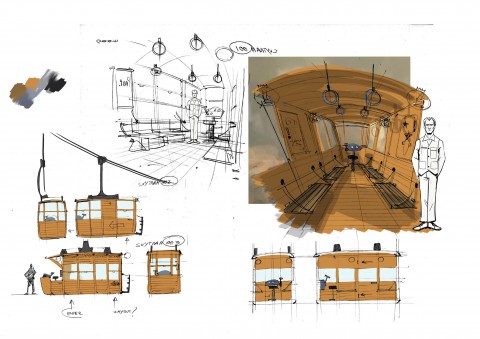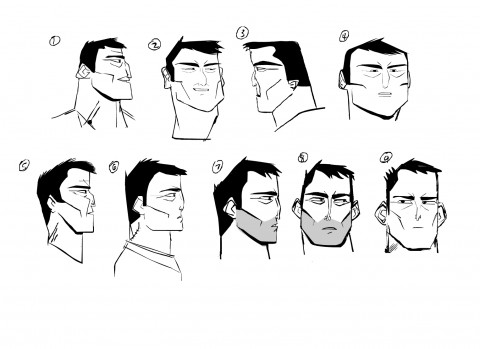
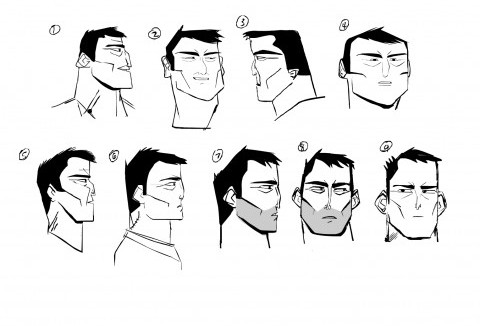
Joel Trussell On Directing Tom Hanks’ New Webseries “Electric City”

He’s lived in Knoxville, Seattle and Los Angeles, but animator Joel Trussell recently moved to a town you won’t find on any map — Electric City. Electric City is the name of the new animated series spearheaded by actor/director Tom Hanks, and it’s one of the first major animation productions specifically designed for online viewing. Premiering today on Yahoo’s video site Yahoo! Screen with ten five- to seven-minute episodes, Electric City is a co-production by Hanks’ Playtone shingle and Los Angeles animation studio Six Point Harness, who tapped Trussell to direct this unique animated series.
Trussell’s career has seen a steady uphill trajectory since graduating from the University of Tennessee-Knoxville in 1998, doing animated music videos to commercials and even segments of television shows like Yo Gabba Gabba. Cartoon Brew has followed Trussell’s career for years, beginning with 2005’s War Photographer music video . After doing a prodigious amount of work out of his Knoxville home far removed from the traditional animation hubs, Trussell moved to Los Angeles in 2009 to pursue opportunities for larger projects. In no short time, Trussell connected with Six Point Harness to do commercials which segued quickly into the opportunity to helm Electric City.
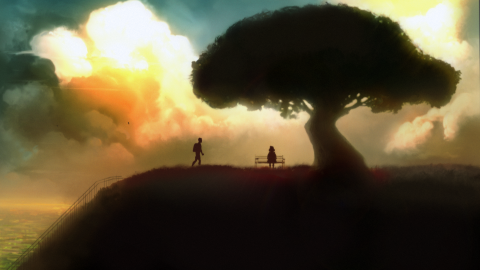
Chris Arrant: Electric City is the biggest project you’ve ever done — 20 episodes, 5 to 7 minutes each. How’d you get involved and did you have any concerns about such a large scale project?
Joel Trussell: For several years I directed animated many music videos (Jason Forrest’s War Photographer, M. Ward’s The First Time I Ran Away) commercials (Esurance, Nicorette) and TV/film segments (Yo Gabba Gabba, The Animation Show) while living in Knoxville, Tennessee. In the fall of 2009 I moved out to Los Angeles and started directing some projects over at Six Point Harness Studios. While I was there Playtone approached Six Point with a request for some spec images and budget for the Electric City series. The owner Brendan Burch felt my experience and style would be a good match for the project and asked me to submit my visual take. I created a handful of images based off a short script Playtone sent, and Six Point pitched me as the director for the project. After a short courtship and a few meetings with Playtone and Tom, they were into it and the deal was done.
The size of the project was collectively bigger than anything I’ve ever worked on, but it was segmented into small chunks for the Internet which I’m used to. I’ve worked for some online series in the past and with my experience in directing many short form spots, I felt confident in taking it on. The fact that this project was going to be creatively challenging actually created more ambition for me rather than fears.
Chris: What made Electric City appealing to you as an animator and director?
Joel: The project was appealing on many levels. Of course the lure of working with Tom Hanks was pretty great, but knowing that he was going to not only star in it but write it as well was totally intriguing. I’m also a big fan of working on unconventional projects no matter what the medium. I’ve worked with puppets, live action, hybrid animation, etc. and what I love most is exploring and creating new styles, techniques and ways of telling stories. After reading the script and seeing earlier incarnations of the project… this was clearly unconventional. It’s definitely not the kind of project that springs to mind when you hear Tom Hanks is creating it…which is what makes it so rad.
Another huge appeal was the great chance to direct on a long-form project (which was the whole reason I moved to California rather than staying in Tennessee) so I was very eager to make it all happen.

Early Head Sketches of main character, Cleveland Carr
Chris: Did you regularly interact with Producer Tom Hanks? If so, how much guidance did he give you?
Joel: This was a total passion project for Tom and he was way more active than I imagined he would be. We had meetings over at the Playtone offices with him; he came down to the Six Point studios and would hang out to review animatics and artwork; and sometimes we’d just get some quick thoughts from him via email saying something like, “We need more sheep in this thing!”
We initially met over at Paramount on the set of Larry Crowne where he was in the midst of directing actors, reviewing takes, acting, and talking to us all at once and making it look graceful and effortless like a boss. It was all very surreal.
Since he had been working on this project for several years, he had a ton of reference material for us and was able to give us specific guidance as we translated his vision into something the budget and timeline could accommodate. Playtone producers Bo Stevenson and Joshua Feldman were also very hands on during the process making sure that we understood the details of this world. Playtone was great to work with and very generous by allowing us to collaborate, explore and experiment with everything from the visual style to story points.
Chris: Electric City’s being promoted not just for its creative side but also its technological prowess, being one of the first major animation projects done specifically for online distribution. Did the venue of the project play any role in how you molded the episodes?
Joel: The venue was definitely taken in to consideration. We knew two main stages for this was going to be on tablets and smart phones, so our images had to hold up for larger screens yet easy to read for smaller screens. The main factors in molding the episodes were how to push the quality up as high as we could to the limit of budget and timeline parameters. Although the budget wasn’t tiny, we weren’t dealing with TV or movie sized financing so we wanted to put every dollar spent on the screen.
Chris: Was the art direction and animation scaled in any special way for its exhibition on the ‘net (as opposed to TV or theatrical)?
Joel: Only a little. We tried to keep our production value as high as possible, but we had the reality of our budget. We knew that animation would have to be limited, so we tried to board strategically focusing more on strong compositions and design rather than flowing “Illusion of Life” animation. My experience with short form work taught me how to use get the most out of economical storyboarding, quick decision making and working at a fast pace which paid off with this project and kept Playtone, Reliance and Six Point happy.
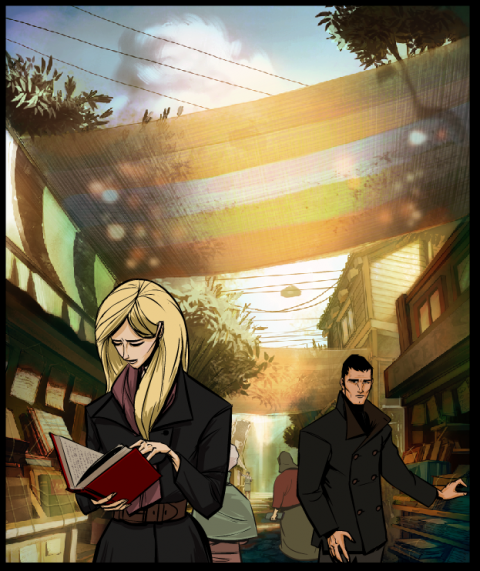
Test image for color palette and atmosphere composition
Chris: You’ve bounced around from working out of your home in Tennessee to Seattle and for the last three years you’ve been in the animation hotbed of Los Angeles. How has it been being able to live and work surrounded by so many fellow animators, and having more animation-related activities to do than in Tennessee?
Joel: Even though I was making a pretty good living at doing music videos and commercials in Tennessee, I still felt the draw of doing longer form content. In order to do that I felt I needed to make the jump to L.A. where I could be around a crew of artists in one place rather than coordinating a handful of artists remotely. Once I came out here (despite bracing myself for the worst) I’ve totally enjoyed it and the opportunities have branched out for developing, directing and designing for places like Disney, Nickelodeon and Cartoon Network. To be honest I don’t actually find myself doing a lot of animation related stuff outside of work, but I like being around creative people of any type. I feel as if I only do animation related things I’ll only revisit already treaded ground. I find it more fun to find new ingredients, mix them all up, and throw them in the oven to see what the new flavor is like. That’s one reason L.A.’s been great.  Being around so much creativity has definitely inspired my own projects.
Chris: Are there any artists you’d like to point to for their special contributions to this project?
Joel: Absolutely! First off, I have to say my small, scrappy crew at Six Point Harness in Hollywood worked with a ton of heart to make this happen. Rafael Hurtado was a master establishing the look of our show’s environments and designing almost every background. Carl Beu was an insane talent leading the way with background painting. Tony Christopherson brought a ton to the plate with his eye for coloring and lighting once we were in post. Andy Suriano and I contributed to the initial character design along with Saharat Tantivaranyoo (IMHO Hollywood’s best character design stud) who ended up shouldering and overseeing most of the character design with Angelo Vilar. Alberto Antinori was a powerhouse in the department of props and vehicles. I was also very lucky to work with the mighty Dave Wasson as the animation director and board supervisor. Marius Alecse was invaluable as our fearless animation supervisor. Ed Skudder made all our specialized fx animation as well as taking on difficult character animation scenes. Animator Joel Moser took command of all 3-D animation as well as a large portion of 2-D character animation. Our producer Samantha Scharff was instrumental in keeping things running smoothly and helped solve the sometimes puzzling logistics of the project. We even had legendary animation artist Jim Smith rocking layouts with us. It was truly a great experience that I’m glad to have been involved with. Hope Mr. Hanks lets us do it again!
